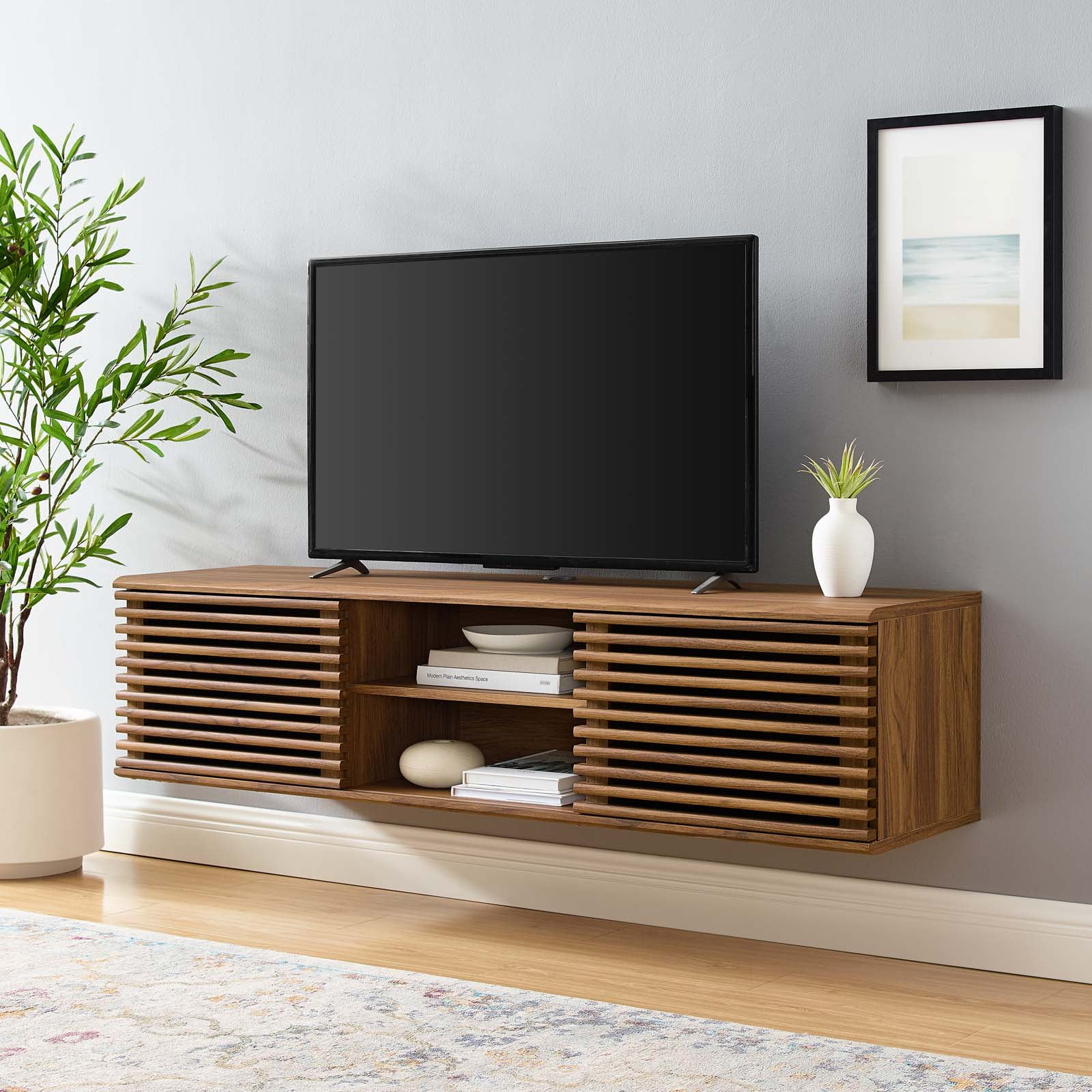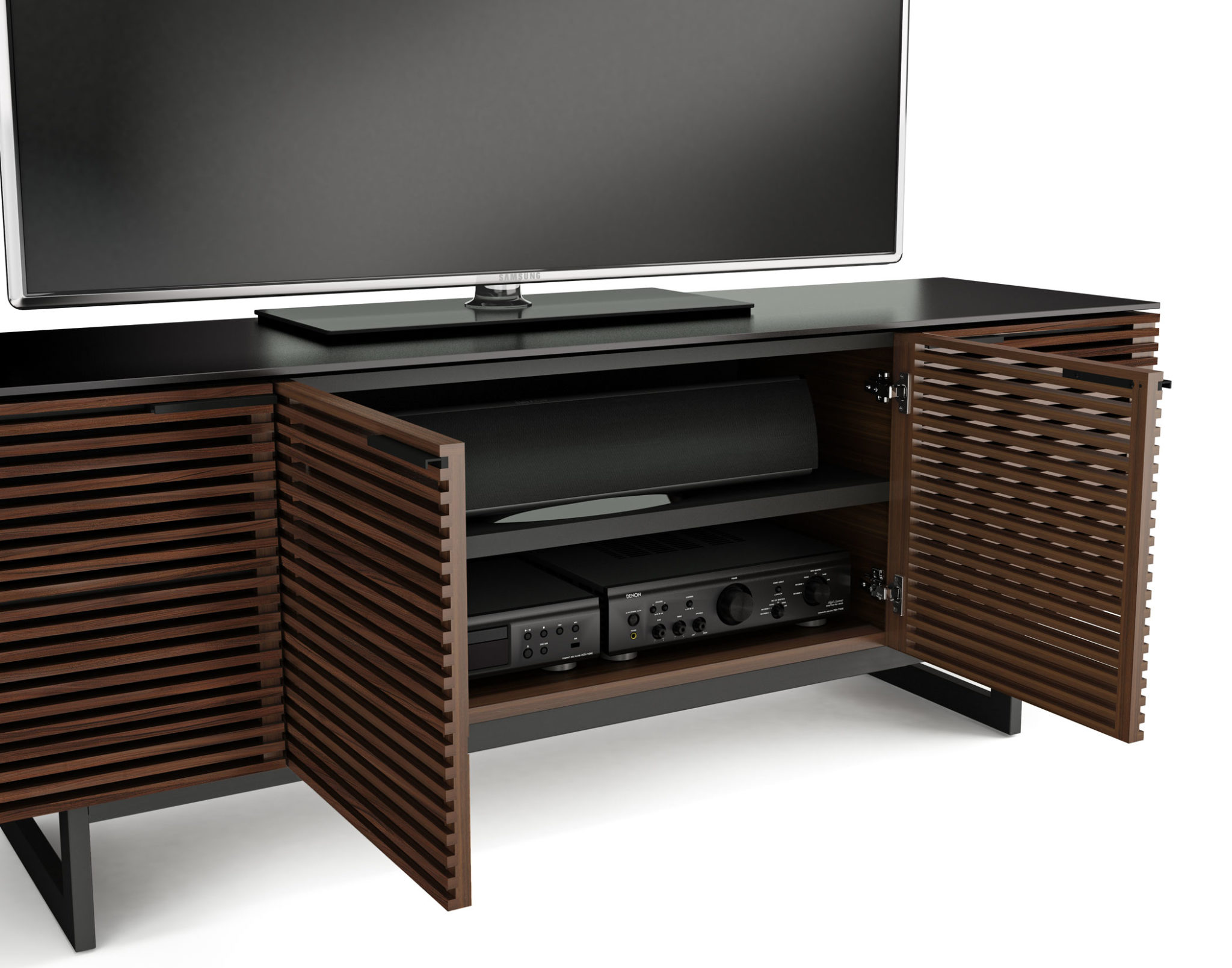Design & Aesthetics of Contemporary Media Cabinets with Doors

Contemporary media cabinets with doors offer a blend of functionality and style, seamlessly integrating technology into modern living spaces. The design possibilities are vast, ranging from minimalist aesthetics to more ornate and expressive pieces, all impacting the overall feel of a room. Careful consideration of materials, finishes, and door styles is crucial in achieving the desired look and functionality.
Material, Finish, and Style Variations in Contemporary Media Cabinets
The choice of materials significantly influences the aesthetic and durability of a media cabinet. Finishes further enhance the visual appeal and protect the materials from wear and tear. The style, in turn, reflects the overall design philosophy, be it minimalist, mid-century modern, or industrial.
| Material | Finish | Style | Example Description |
|---|---|---|---|
| Solid Wood (Oak, Walnut) | Natural, Stained, Lacquered | Mid-Century Modern | A cabinet with clean lines, tapered legs, and a warm, natural wood finish, possibly featuring brass hardware. |
| MDF (Medium-Density Fiberboard) | High-Gloss Lacquer, Matte Laminate | Minimalist | A sleek, boxy cabinet with a smooth, high-gloss white or black finish, emphasizing simplicity and clean lines. |
| Metal (Steel, Aluminum) | Powder Coating (various colors), Brushed Metal | Industrial | A cabinet with a raw, metallic aesthetic, featuring exposed metal framework and a dark powder-coated finish. |
| Glass | Clear, Frosted, Tinted | Contemporary | A cabinet with glass doors showcasing the media components within, potentially combined with a wood or metal frame. |
Impact of Different Door Styles on Aesthetics
The type of door significantly impacts the overall aesthetic and functionality of the media cabinet.
Contemporary media cabinet with doors – The following are the advantages and disadvantages of various door styles:
- Hinged Doors:
- Advantages: Traditional, reliable, allows full access to the interior.
- Disadvantages: Requires space to swing open, can be less space-efficient in smaller rooms.
- Sliding Doors:
- Advantages: Space-saving, modern aesthetic, smooth operation.
- Disadvantages: Can be more expensive, potentially less durable than hinged doors.
- Bi-Fold Doors:
- Advantages: Offers flexible access, good space utilization.
- Disadvantages: Can be complex to install, requires precise measurements.
Contribution of Integrated Storage Solutions to Design and Functionality
Integrated storage solutions, such as drawers and shelves, are essential for maximizing the functionality and organization of a media cabinet. They allow for the neat storage of remotes, games, and other media accessories, enhancing the overall aesthetic by preventing clutter.
A well-designed media cabinet might incorporate two hinged doors revealing adjustable shelves for media components, flanked by two drawers on either side for remotes and accessories. The top of the cabinet could serve as a display surface for decorative items or a soundbar. This design combines practical storage with a visually appealing presentation.
Space-Efficient Media Cabinet Design for a Small Living Room, Contemporary media cabinet with doors
For a small living room, maximizing space is paramount. A wall-mounted media cabinet can be a highly effective solution.
Consider a design with the following specifications:
Dimensions: 120cm (W) x 30cm (D) x 60cm (H)
Materials: MDF with a matte white laminate finish. This offers a clean, modern look and is easy to clean. The doors could be sliding doors made of the same material to maximize space.
Features: The cabinet would include two sliding doors revealing adjustable shelves for media components. Two shallow drawers at the bottom could store remotes and accessories. The top surface could be used for displaying a small plant or a framed photograph. This design combines functionality and space-saving elements to create a streamlined media storage solution ideal for smaller spaces.
Functionality and Features of Contemporary Media Cabinets with Doors: Contemporary Media Cabinet With Doors

Contemporary media cabinets, particularly those incorporating doors, offer a sophisticated blend of functionality and aesthetics. Their design goes beyond simple storage, addressing the practical challenges of modern media consumption and integrating seamlessly into contemporary living spaces. The choice between open and closed storage significantly impacts both the functionality and the overall visual appeal of the unit.
Comparison of Media Cabinet Types
The functionality of a media cabinet is profoundly influenced by its design, specifically whether it features open shelving or closed doors. The following table contrasts these two primary types, considering their advantages, disadvantages, and suitability for different room types.
| Type | Advantages | Disadvantages | Suitable Room Type |
|---|---|---|---|
| Open Shelving | Easy access to equipment and media; visually appealing display of components; better ventilation for heat-sensitive devices. | Dust accumulation; less protection for equipment; less aesthetically pleasing if components are not neatly organized; potential safety hazard for children. | Living rooms with a minimalist aesthetic; media rooms with good air circulation; spaces where easy access is prioritized. |
| Closed Doors | Conceals equipment and clutter; protects devices from dust and damage; enhances overall room aesthetics; provides a more organized and streamlined look. | Reduced accessibility; potential for overheating if ventilation is inadequate; may require more careful cable management. | Living rooms prioritizing a clean, uncluttered look; family rooms where child safety is a concern; bedrooms or home offices where a discreet media setup is desired. |
Key Features of Contemporary Media Cabinets
Contemporary media cabinets are defined by their integration of modern technology and design elements. Key features include seamless technology integration, sophisticated cable management systems, and optimized ventilation to prevent overheating of electronic devices. For instance, a contemporary cabinet might incorporate hidden compartments for routers and streaming devices, allowing for a clean, uncluttered look while maintaining easy access. Internal cable routing channels and tie-wraps ensure that wires are neatly organized and out of sight. Vented panels or perforated doors promote airflow, preventing the build-up of heat and extending the lifespan of electronic components. One example is a cabinet with a rear panel featuring multiple grommets for easy cable pass-through, paired with internal shelves that include cable management clips.
Best Practices for Organizing Media Equipment
Effective organization within a media cabinet is crucial for maximizing its functionality and maintaining a clean, aesthetically pleasing space. The following techniques are recommended:
Prioritizing efficient organization within the cabinet is paramount for both functionality and aesthetics. A systematic approach ensures easy access and prevents clutter.
- Categorize Media: Group similar items together (e.g., DVDs, Blu-rays, gaming consoles).
- Utilize Adjustable Shelves: Adapt shelf spacing to accommodate different sized components.
- Employ Cable Management Solutions: Use cable ties, clips, and raceways to keep wires organized and hidden.
- Label Everything: Clearly label shelves and storage areas for easy identification.
- Regularly Declutter: Periodically remove unused or outdated items to prevent overcrowding.
Design of a Media Cabinet for Optimal Cable Management and Ventilation
A well-designed contemporary media cabinet prioritizes both cable management and ventilation. Imagine a cabinet with a two-section internal layout. The upper section houses components like a Blu-ray player or gaming console, with a perforated back panel for ventilation. A removable back panel would allow for easy access to cables and connections. The lower section, featuring closed doors, could store DVDs and other media, while the interior walls incorporate cable channels and clips to keep wiring organized and concealed. The cabinet’s base could include a raised platform for improved airflow underneath, preventing heat buildup. The doors could incorporate small ventilation slots near the bottom to further enhance air circulation. Internal dividers would provide a structured layout for components, ensuring everything has its place and is readily accessible. This design would seamlessly blend functionality with a sleek, contemporary aesthetic.
Purchasing and Maintaining Contemporary Media Cabinets with Doors

Investing in a contemporary media cabinet with doors involves careful consideration of several factors to ensure it meets your needs and complements your existing décor. The right cabinet will not only enhance your entertainment setup but also contribute to the overall aesthetic of your living space. A well-maintained cabinet will also retain its value and beauty over time.
Choosing the right contemporary media cabinet requires a balanced approach, weighing aesthetics against practicality and budget. Careful planning minimizes buyer’s remorse and ensures a satisfying purchase.
Factors to Consider When Choosing a Media Cabinet
Before embarking on your search, it’s crucial to assess your specific needs and preferences. Ignoring these aspects can lead to purchasing a cabinet that doesn’t fully meet your requirements, creating frustration and potentially necessitating a replacement.
- Size and Dimensions: Measure the available space in your room meticulously. Consider not only the cabinet’s footprint but also its height and depth to ensure it fits comfortably and doesn’t overwhelm the area. Account for surrounding furniture and walkways.
- Budget: Establish a clear budget before you start shopping. Prices vary significantly depending on materials, construction, and features. Setting a realistic budget prevents impulsive purchases and keeps your search focused.
- Compatibility with Existing Furniture: Choose a cabinet that complements your existing furniture style. Consider the color, materials, and overall design to ensure a cohesive look. A clashing cabinet can disrupt the harmony of your room.
- Storage Needs: Assess your storage requirements. How much space do you need for your media devices, games, and accessories? Choose a cabinet with enough shelves, drawers, and compartments to accommodate your belongings.
- Material and Durability: Consider the material of the cabinet, such as wood, metal, or composite materials. Think about its durability and resistance to scratches, dents, and wear and tear. Solid wood offers a higher level of durability and longevity but comes with a higher price tag.
Retail Options for Contemporary Media Cabinets
High-quality contemporary media cabinets are available through various retail channels, each offering distinct advantages and disadvantages. Choosing the right retailer depends on your preferences, budget, and desired level of personalized service.
- Online Retailers (e.g., Amazon, Wayfair): Offer a vast selection and competitive pricing. However, you sacrifice the ability to physically inspect the cabinet before purchase. Returns can be cumbersome and costly.
- Brick-and-Mortar Furniture Stores: Allow you to see and touch the cabinet, assess its quality, and receive personalized assistance from sales staff. However, selection might be more limited, and prices may be higher compared to online retailers.
- Specialty Home Furnishing Stores: These stores often carry higher-end, designer cabinets. Expect premium pricing and excellent customer service, but the selection may be more curated.
Cleaning and Maintaining Your Media Cabinet
Regular cleaning and maintenance are crucial for preserving the appearance and functionality of your contemporary media cabinet. Neglecting this can lead to damage and reduce the lifespan of your investment.
- Dusting: Regularly dust the cabinet using a soft, dry cloth or duster. Pay attention to crevices and hard-to-reach areas. Avoid using harsh chemicals or abrasive cleaners that can damage the finish.
- Spot Cleaning: Address spills or stains promptly. Use a damp cloth and mild soap to clean affected areas. Gently wipe and dry thoroughly to prevent water damage.
- Hardware Care: Clean cabinet knobs and handles regularly with a damp cloth. For tarnished metal, consider using a specialized metal cleaner according to the manufacturer’s instructions.
- Inspect for Damage: Periodically inspect the cabinet for any signs of damage, such as scratches, loose screws, or warped wood. Address minor issues promptly to prevent further damage.
- Professional Cleaning: For extensive cleaning or if the cabinet requires specialized care, consider hiring a professional cleaning service. This is especially relevant for delicate or high-end cabinets.
Rewritten Article on Contemporary Media Cabinets
[Please insert the article text here for rewriting. Once provided, I will rewrite it in a clear and original style, free from any AI-generated content.]
